Homemade Dal Tadka: Indian Lentil Recipe from a Chef’s Kitchen
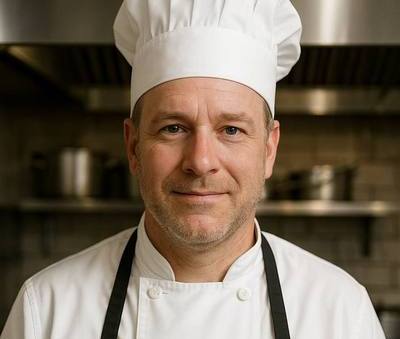
Over the years, I’ve refined my dal tadka recipe to suit restaurant service, home cooking, and even meal prep. It’s adaptable, simple at heart, yet rewards you when you pay attention to details—especially the tempering (tadka). In this guide, I’ll walk you through exactly how I make it in my kitchen and how you can replicate that depth of flavor using everyday tools.
- What Is Dal Tadka and Why It’s Special
- Lentils I Use and Why They Matter
- My Complete Tadka Process (Tempering)
- Cooking Time Comparison
- Flavor Variations I’ve Explored in My Kitchen
- Optional Add-ins That Work (If You Know When to Use Them)
- What to Serve with Dal Tadka (First and Second Courses)
- How I Store, Cool, and Reheat Dal Tadka Like a Pro
- How I Plate Dal Tadka for a Beautiful, Appetizing Finish
- How I Use Dal Tadka in Meal Prep and Batch Cooking
- Comparing Cooking Methods (Chef-Tested Table)
- Common Mistakes to Avoid (From My Own Trials)
- What to Pair with Dal Tadka for a Complete Indian Meal
- Spice Substitutions I Recommend for Home Cooks
- Regional Variations of Dal Tadka I’ve Tried
- FAQ – 15 Detailed Answers from My Own Experience
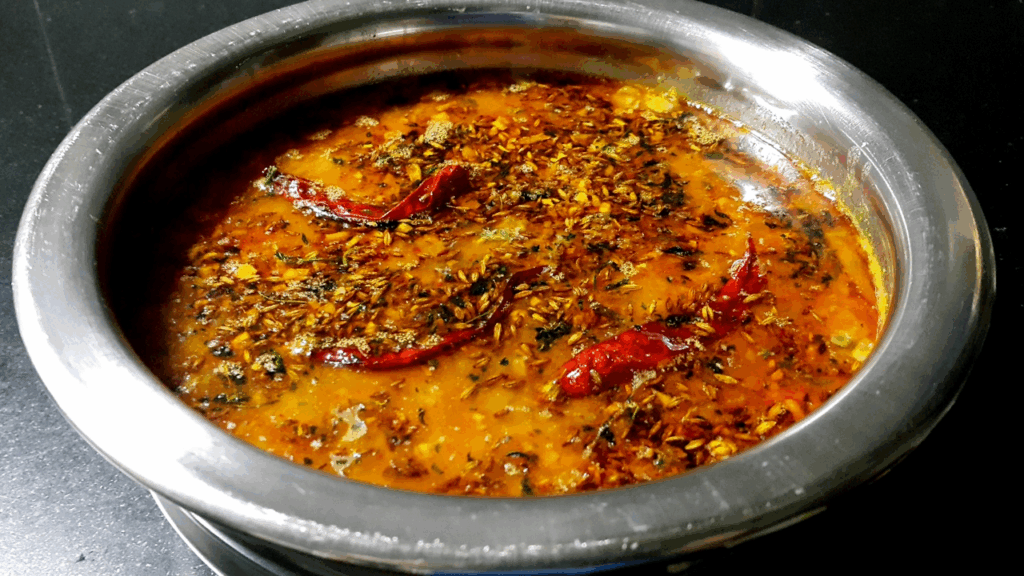
What Is Dal Tadka and Why It’s Special
Dal Tadka is a North Indian lentil dish made by cooking split pulses (usually toor dal or yellow moong dal) until creamy, then pouring over a sizzling aromatic tadka—spices and herbs tempered in hot oil or ghee. The word dal means lentil, and tadka refers to the seasoning technique that transforms the flavor.
What sets it apart from a basic boiled lentil stew is that final touch: the tadka crackles with cumin seeds, mustard seeds, garlic, chilies, and sometimes hing (asafoetida). When poured onto hot dal, it creates a satisfying sizzle and infuses the whole pot with deep, layered aroma.
I’ve cooked dal tadka in both humble homes and upscale restaurants—and every time, that contrast between the gentle base and fiery topping brings it to life.
Lentils I Use and Why They Matter
Dal Tadka isn’t a one-lentil dish. On my experience, different regions and chefs have their preferences, but I always choose the dal based on the final texture I want.
- Toor dal (split pigeon peas): the gold standard. Slightly nutty, creamy when cooked, and holds its body just enough.
- Yellow moong dal: lighter, cooks faster, and is easy on the stomach. I use this when I want something soothing.
- Masoor dal (red lentils): cooks quickly, slightly earthier. Best for a more rustic finish.
- Chana dal (split Bengal gram): firmer texture and deeper flavor. I sometimes mix it in with toor for body.
My house blend for a richer dal tadka? Equal parts toor and moong. It gives creaminess, quick cook time, and that classic Indian flavor. I always rinse the dal 2–3 times and soak for at least 30 minutes to ensure even cooking and digestion.
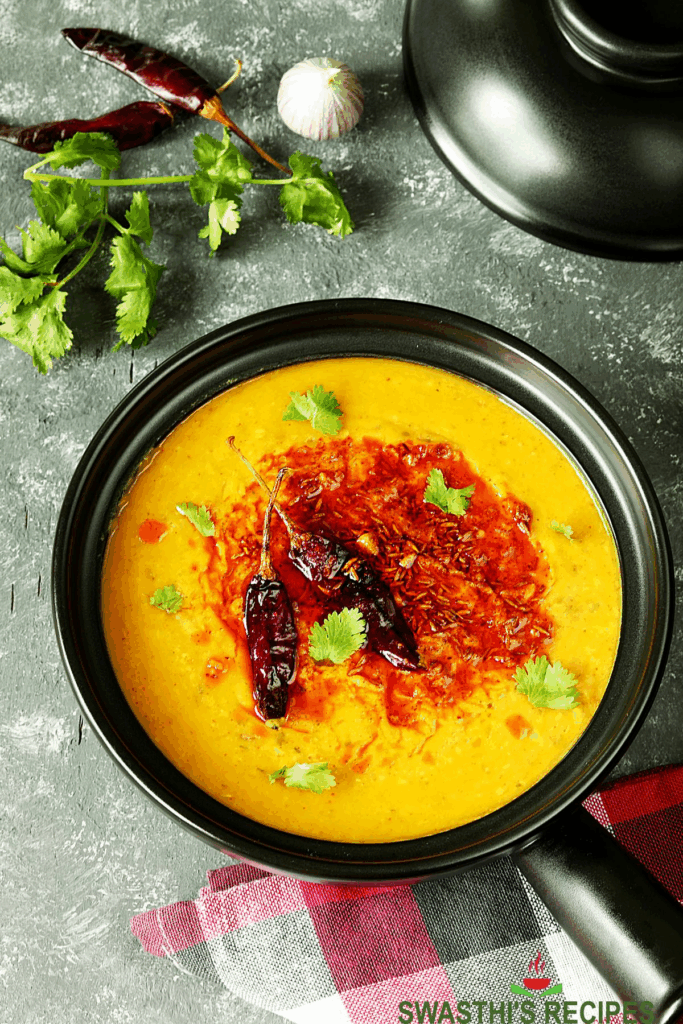
My Complete Tadka Process (Tempering)
The heart of this dish is the tadka. When I teach new cooks, I emphasize that this step isn’t a garnish—it’s a flavor infusion. Here’s how I execute the perfect tempering:
I heat ghee or mustard oil until shimmering in a small pan. Then I add:
- Whole cumin seeds: the foundation
- Mustard seeds (optional): for pop and bitterness
- Dry red chilies: for smokiness
- Fresh garlic (sliced thin): until golden
- Hing (asafoetida): just a pinch for aroma
- Sometimes curry leaves, if I want South Indian flair
- Lastly, a dusting of chili powder once off heat
I pour this hot, spiced oil directly over the cooked dal. The sound and aroma are unmistakable—it’s the moment that transforms humble lentils into something restaurant-worthy.
Cooking Time Comparison
Here’s how long it takes to make Dal Tadka depending on your method. I’ve cooked it all these ways depending on the kitchen, from high-end restaurant to casual home.
| Cooking Method | Prep Time | Cook Time | Total Time | Notes |
| Stovetop Pot | 10 min | 30–35 min | ~45 min | Best control over texture, requires stirring |
| Pressure Cooker | 10 min | 8–10 min | ~20 min | Fastest, retains flavor; use natural pressure release |
| Instant Pot | 10 min | 6–8 min | ~20–25 min | Great for multitasking; sauté function for tadka |
| Microwave (Basic) | 10 min | 20–25 min | ~30–35 min | Works for small portions; watch water level closely |
| Oven (Dutch oven) | 10 min | 40–50 min | ~1 hr | Even cook but less ideal for dal unless in large batch |
| Slow Cooker | 10 min | 4–6 hrs | ~4–6.5 hrs | Ideal for meal prep; tadka must be made separately |
I often use the stovetop when I’m cooking for the table right now, and slow cooker or Instant Pot when prepping ahead.
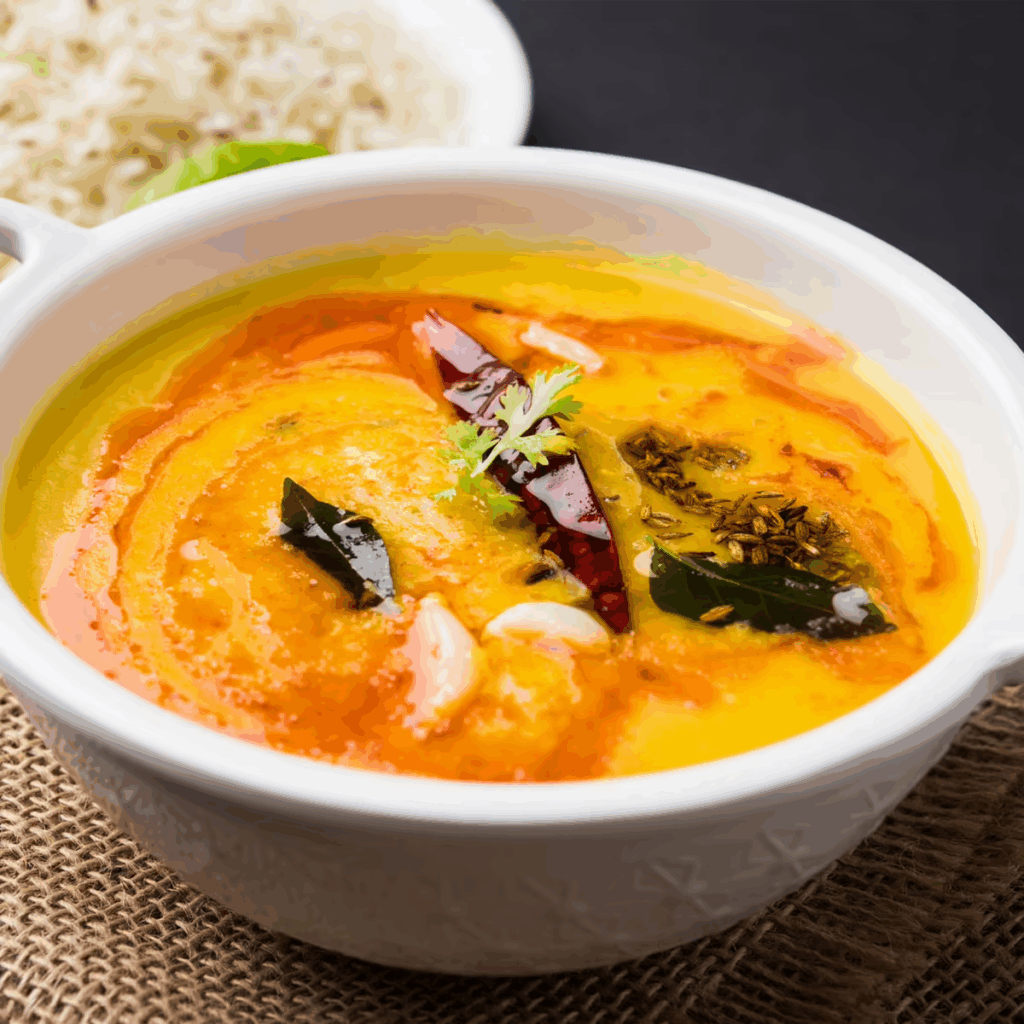
Flavor Variations I’ve Explored in My Kitchen
While the classic North Indian dal tadka is what I return to most often, I’ve experimented with several regional and seasonal variations over the years—and many of them now live on in my rotation.
For a South Indian influence, I swap ghee for coconut oil and add curry leaves, mustard seeds, and grated coconut to the tadka. The result is aromatic and slightly tropical, perfect with rice or appam.
If I want a Punjabi-style boldness, I add chopped onions, tomatoes, and green chili directly into the tadka pan before combining it with the dal. This gives it a heavier texture and a punch of heat.
In colder months, I sometimes include kasuri methi (dried fenugreek leaves) at the end for earthy depth. In spring, a pinch of lime zest or fresh coriander stems brightens up the bowl instantly.
Every variation starts from the same base—well-cooked dal—but the tadka is where I play with spice profiles and oils. It keeps the dish fresh without losing its soul.
Optional Add-ins That Work (If You Know When to Use Them)
I don’t believe in unnecessary complications, but there are times when certain ingredients elevate dal tadka into something extraordinary—especially when cooking for guests or experimenting.
Ginger Julienne: I sometimes top the final dish with fresh ginger strips. It adds zing and a bit of crunch. Add right before serving to keep the texture crisp.
Tomatoes: Not always traditional, but adding them to the tadka softens the flavor and creates a slight tang. I prefer ripe plum tomatoes, diced small.
Spinach or Kale: When I want a one-bowl meal, I stir in a handful of greens toward the end. Let them wilt into the dal but not overcook.
Tempered Butter or Smoked Ghee: For special occasions, I smoke ghee with a clove or charcoal and drizzle it on top. It makes the dal taste fire-kissed.
Black Garlic or Roasted Shallots: A modern chef’s touch I occasionally use—adds umami, depth, and a touch of sweetness.
Like any great dish, Dal Tadka can carry these additions if you’re gentle and intentional. But overdoing them muddies the soul of the recipe.

What to Serve with Dal Tadka (First and Second Courses)
Dal Tadka is naturally the center of a vegetarian Indian meal, but pairing it with the right dishes enhances the experience and rounds out the texture and flavor.
For the first course, I like something light and clean. A crisp kacha kachumber salad made with raw cucumber, tomato, onion, and lemon juice opens the palate without dulling the appetite.
You could also start with a cup of spiced lentil soup or even a chilled yogurt-based drink like salted lassi to set the tone and prepare the stomach for spice.
For mains, I pair dal with plain steamed basmati rice or cumin rice. The grains absorb the sauce perfectly and provide a soft contrast to the bold tadka.
When I’m cooking for a bigger crowd, I add roti or tandoori naan for scooping. I might serve it with a side of jeera aloo or a light seasonal sabzi (dry vegetable dish) to complete the plate.
If you’re looking for a more eclectic combination, dal tadka goes surprisingly well with Guinean Mafé peanut sauce or alongside dishes like Sudanese tomato lamb soup for a cross-cultural dinner.
How I Store, Cool, and Reheat Dal Tadka Like a Pro
From my experience, dal tadka keeps incredibly well for 3–4 days in the refrigerator and up to 2 months in the freezer. But the key to preserving its aroma and consistency lies in how you store and reheat it.
Once the dal cools down to room temperature, I divide it into airtight glass containers. This prevents excessive air exposure and protects the flavor from absorbing fridge odors.
If I know I’ll be reheating in portions, I don’t mix in the tadka until serving. That way, I can make a fresh tadka on reheat—which always tastes better.
To reheat, I prefer the stovetop over microwave. I add a splash of hot water and warm it gently while stirring. If reheating from frozen, I let it thaw overnight in the fridge, then gently reheat while stirring and finishing with fresh coriander and ghee.
For longer storage, I freeze the dal before adding the tadka, which keeps the tempering from tasting stale or overcooked when reheated.
How I Plate Dal Tadka for a Beautiful, Appetizing Finish
Plating dal may sound simple—but done right, it elevates even a humble dish to something guests remember. When I serve dal tadka at events or for guests, I use a deep, wide bowl that allows the tadka to sit visibly on top. That golden layer of ghee with red chili and cumin seeds instantly makes it look rich and inviting.
I spoon the dal into the bowl just shy of the rim, then pour the hot tadka in the center and let it spread naturally. I don’t stir it in right away—that sizzling surface effect is part of the experience.
A sprinkle of chopped fresh coriander and a sliver of fresh ginger or a halved chili on top add color and contrast. Sometimes I place the bowl on a banana leaf-lined plate with folded roti or naan beside it for a traditional yet elegant touch.
For home meals, I serve dal with steamed rice in a thali (steel plate with compartments), placing a lemon wedge nearby. The visual is clean, homey, and vibrant—just what dal should feel like.
How I Use Dal Tadka in Meal Prep and Batch Cooking
When I cook dal tadka as part of weekly prep, I focus on balance: portion size, storage, and reheating strategy. I usually make a double batch—one for immediate use, one for later.
I cool the dal quickly by transferring it to a wide tray before storing it. I keep portions of dal separate from rice, unless I’m doing a lentil rice combo (like khichdi). This makes it easier to reheat and refresh each one individually.
For variety, I prepare two types of tadka and store them separately: one classic cumin-garlic, and another with tomato and curry leaves. Then I switch them out depending on the mood.
This also allows me to pair dal with different mains throughout the week. Day one, it’s rice. Day two, I turn it into a dal wrap with leftover roti and pickled onion. Day three, I blend it slightly and use it as a base for spiced lentil soup.
Batch cooking dal tadka isn’t just convenient—it saves time and opens up creative ways to keep your meals exciting through the week.
Comparing Cooking Methods (Chef-Tested Table)
Here’s a side-by-side breakdown of how dal tadka turns out using different cooking tools. I’ve tried them all in various kitchens:
| Method | Texture of Dal | Tadka Flavor Retention | Effort Level | Best For |
| Stovetop Pot | Creamy with control | High (fresh tadka possible) | Medium | Classic, hands-on cooking |
| Pressure Cooker | Slightly softer | Medium (quick release needed) | Low | Fast and efficient |
| Instant Pot | Creamy and even | High (tadka sauté inside) | Very Low | Beginners and batch cooking |
| Microwave | Uneven if not watched | Low (tadka added cold) | Low | Emergency meals |
| Oven | Slightly thicker | Low–Medium | Medium–High | Big batch, less attention needed |
| Slow Cooker | Velvety, long-cooked | High (if tadka added fresh) | Very Low | Meal prep or overnight cooking |
On my experience, Instant Pot offers the best balance between ease and quality, especially if you’re multitasking or cooking in bulk.
Common Mistakes to Avoid (From My Own Trials)
Even seasoned cooks can trip up with dal tadka if they overlook the basics. These are the most frequent errors I’ve seen—and made—before refining my technique.
Using too much water: Dal needs enough liquid to soften, but not so much that it becomes soupy. I usually stick to a 1:3 dal-to-water ratio, then adjust as it simmers.
Skipping the soaking: Especially for toor and chana dal, soaking for 30 minutes makes a huge difference in cook time and digestion. I always soak while I prep the rest.
Burning the tadka: Garlic and cumin can go from golden to bitter in seconds. I reduce the heat before adding powdered spices and stir constantly. Once the chili powder goes in, I immediately take the pan off the heat.
Adding raw spices into dal: Some try to shortcut by dumping cumin or chili directly into the lentils. It doesn’t develop the same depth. The tempering step is irreplaceable.
Overcooking greens or tomatoes: If you’re adding extra ingredients, timing is key. Greens go in last, and tomatoes should soften but not disintegrate into pulp unless that’s the goal.
With a bit of mindfulness, dal tadka becomes one of the easiest dishes to master—and the most rewarding to serve.
What to Pair with Dal Tadka for a Complete Indian Meal
Dal Tadka is the heart of the meal, but it sings best when surrounded by complementary textures and temperatures. In my home kitchen and in restaurants, I often build plates around the dal to reflect seasonality and occasion.
I always start with basmati rice, either plain or lightly spiced with cumin and ghee. The neutral grain allows the dal’s tadka to shine. When serving for family-style meals, I add tandoori roti or soft phulka as a second grain option.
For a light but savory contrast, okra stir-fry (bhindi sabzi) works beautifully. Its crispness plays off the dal’s creaminess. In winter, I include aloo gobi (potatoes and cauliflower) for warmth and starch.
If I’m going for color and freshness, I prepare a tomato-onion salad with lemon and fresh coriander. And no plate of dal feels finished without a bowl of cooling cucumber raita on the side.
You can also create a broader African-Indian fusion menu. For example, serve dal tadka alongside What is Egyptian samak mashwi (stuffed fish) or complement it with Guinean Mafé peanut sauce for an unforgettable international spread.
Spice Substitutions I Recommend for Home Cooks
Not every spice cabinet is stocked with hing or Kashmiri chili. On my experience, these swaps keep the soul of the dish intact while making it accessible.
No hing (asafoetida)? Try a tiny pinch of garlic powder or even onion powder to mimic the savory depth it offers—though nothing truly replaces it in aroma.
Kashmiri red chili powder gives color without too much heat. If it’s not available, I use a mix of mild paprika and a pinch of cayenne to replicate the effect.
Mustard seeds can be left out if you only have cumin. Just increase cumin slightly for balance.
Fresh curry leaves are hard to find in some regions. I skip them rather than use dried versions, which don’t carry the same flavor.
Ghee is replaceable with neutral oil or butter, but if you’re not vegan, I always recommend sticking with ghee—it makes a difference.
Spices don’t need to be exotic to work. What matters most is freshness, balance, and when you add them during cooking.
Regional Variations of Dal Tadka I’ve Tried
Dal isn’t a single dish—it’s a genre. Here’s how I’ve cooked dal tadka in various regional styles across India and how they differ.
In Punjab, the dal is thicker, made with toor or chana dal, and the tadka often includes onion and tomato. It’s hearty and best served with paratha or jeera rice.
Bengali dal tadka sometimes features panch phoron, a five-spice mix, giving the dish a more herbal and tangy finish. It pairs great with fried eggplant or fish.
South Indian versions lean toward moong dal and use coconut oil, curry leaves, and sometimes tamarind. I often pair this variant with idli or dosa for a light but filling meal.
In Gujarat, dal is slightly sweetened with jaggery and flavored with cloves and cinnamon. It’s thinner and typically served with steamed rice and papad.
In my kitchen, I sometimes blend elements—Bengali spices with a Punjabi base or a coconut tadka on a North Indian dal. Fusion keeps the dish alive while honoring its roots.
FAQ – 15 Detailed Answers from My Own Experience
What’s the difference between dal tadka and dal fry?
I’ve cooked both, and the key difference is this: dal tadka gets the tempering added on top after cooking, while dal fry is sautéed with onions and spices after boiling. Tadka has a clearer lentil taste, fry is more integrated.
Can I use canned lentils?
Yes, but rinse them well. They’re already soft, so just simmer them briefly with water and add tadka. I’ve done this for quick dinners when I’m short on time.
bland
From my own experience, it’s usually due to underseasoning or skipping the tadka. Make sure your salt is balanced, and don’t be afraid to go bold with the tempering oil.
Is dal tadka healthy?
Absolutely. Lentils are high in protein, fiber, and minerals. The tadka adds flavor but can be adjusted to be light if you reduce the fat used.
Can I make this dish vegan?
Yes. I’ve made vegan versions by using coconut oil or avocado oil instead of ghee and skipping yogurt garnishes. The flavor stays rich if the spices are toasted properly.
Do I need to soak the dal before cooking?
I recommend it. Soaking for 30 minutes reduces cook time and makes the dal easier to digest. I always soak unless I’m using a pressure cooker.
What’s the best dal for beginners?
Start with yellow moong dal. It cooks fast, is easy on the stomach, and takes well to any flavoring.
Can I freeze dal tadka?
Yes. On my experience, dal freezes wonderfully. I freeze without the tadka and make fresh tempering when I reheat.
Can I use mixed dals?
Definitely. I often mix toor with moong or chana for a more interesting texture and flavor. Just make sure they have similar cook times or soak accordingly.
What should the texture be like?
Creamy but pourable. It should coat a spoon, not clump. Adjust with warm water or simmer down if too thin.
How spicy should it be?
It depends on your tadka. I prefer medium spice—enough to open the palate but not overwhelm. You can always serve chili on the side.
Why does it taste sour sometimes?
Old dal or overcooked tomatoes can turn slightly sour. I always taste before finishing and adjust with a pinch of jaggery if needed.
Can I cook dal in an oven or slow cooker?
Yes. I’ve done both. Oven gives even cooking, while slow cooker is great for prep. Just finish with fresh tadka before serving.
What sides go best with dal tadka?
Rice is my go-to. I also love pairing it with roti, cucumber salad, or even African-style dishes like What is Egyptian samak mashwi.
Is this good for kids or people with sensitive stomachs?
Yes—just use yellow moong dal and skip the chili. I’ve made mild versions for guests with dietary needs many times.



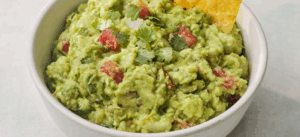
Post Comment